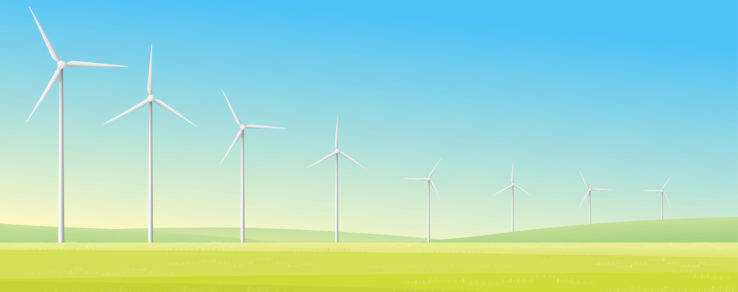U.S. wind power generation has tripled over the past decade — and continues to grow as renewable energy gains momentum. However, the small wind market (<100 kW), dominated in the past by residential customers, has largely been supplanted by solar installations. By comparison, commercial and industrial companies have installed over 360 onsite wind turbines. Excluding independent power producers and municipals, the average installation size is roughly 800 kW ranging from 50 kW to 3 MW in size according to the United States Wind Turbine Database. Before investing in wind power, your utility’s commercial and industrial customers need to understand the keys to wind power success.
What is the energy output of wind power?
Power is proportional to the cube of wind speed. Increasing average wind speed from 14 to 16 mph increases power by 50%. Wind turbine installers generally recommend a minimum average wind speed of at least 12 miles per hour (Class 3 wind). Your customer’s wind resource can vary significantly over just a few miles, due to changes in local terrain. Direct customers to the U.S. Department of Energy’s (DOE) wind resource maps to estimate average wind speeds in their area or have them obtain wind speed data from a local airport or weather station.
Wind speed also increases as tower height increases. Wind speed at 164 feet is 25% higher than at 33 feet and doubles power output. Commercial-scale wind turbines are placed on towers that range from about 75 feet (25 meters) to as much as 325 feet (100 meters) tall.
Power is proportional to the square of the blade length. Increasing blade length from 6 feet to 12 feet increases power output four times. Combining larger blades with higher tower height maximizes output.
A wind turbine does not output at its maximum capacity all the time. Sometimes there is no wind at all. A capacity factor of around 25% is assumed for non-utility-scale turbines in the U.S.
Installation and maintenance of wind turbines
Before your customer invests in a small wind energy system, have them contact their local building inspector or zoning board to find out about any zoning or permitting issues. The board can tell them if they will need to obtain a building permit and provide them a list of requirements.
Wind power safety issues
In high wind conditions, the generator and gear box can run too fast and overheat. All wind turbines disengage the generator at some predetermined cutout wind speed (typically 55 mph). A wind turbine will also need lightning protection.
What’s the best wind turbine size?
The turbine size will depend on your customer’s energy use, the average wind speed at their site, the diameter at the blade tips and the height of the wind turbine, all of which will affect the amount of energy it generates. When wind turbine capacity is augmented by energy storage (during slow wind conditions), energy storage is sized to provide only about 14% of turbine full capacity.
Financial analysis and incentives for wind power
The Taxpayer Certainty and Disaster Tax Relief Act of 2020 extended the deadline for wind projects started in either 2020 or 2021 to qualify for a Production Tax Credit (PTC) of $0.015/kWh on the electrical output for 10 years.Wind projects can receive the tax credit based on either the year the project begins operation or the year in which 5% of the total capital cost for the project has been spent and construction has begun. The credit is claimed by completing IRS Form 8835, “Renewable Electricity Production Credit.” The Investment Tax Credit (ITC), previously at 30%, is no longer available for on-shore wind projects.
Conducting a simple investment analysis for your customers can help them understand the financial obligations of wind power more clearly. For example, the assumptions and calculation below outlines how to estimate the total net cost and payback of an average-size onsite wind turbine.
Assumptions:
- 800 kW capacity @$3,500/kW installed cost (<= 5 MW) per LBL
- Operations and maintenance (O&M) costs of $30/kW-year
- Commercial electricity rate = $0.11/kWh
- Wind power Renewable Energy Credit (REC) prices vary from $1 to $10 per megawatt-hour (MWh) in most states
- Annual electricity production = 800 kW x 0.25 capacity factor x 8,760 hrs/yr = 1,752,000 kWh
Calculation:
- Initial investment = 800 kW x $3,500/kW = $2.8 million
- PTC incentive = 1,752,000 kWh x $0.015/kWh x 10 years = $262,800
- REC sales = 1,725 MWh/yr x $4/MWh x 20 years = $138,000
- O&M cost = 800 kW x $30/kW x 20 years = $480,000
- Initial investment – PTC incentive – REC sales + O&M = $2.88 million total cost
- Annual electricity savings = 1,752,000 kWh x $0.11/kWh = $192,720 annual savings
With a total cost of $2.88 million and electricity savings of $192,720 per year, customers can expect simple payback in 15 years. That’s an internal rate of return of 3.1%, or a net present value of $36,956 (assuming a discount rate of 3%).
Is wind power right for your customers?
Being green is not inexpensive. Your customers can also experience pushback in the form of NIMBY or “not in my back yard.” But it is a great solution with respect to decarbonization of power generation. The wind “fuel” is free. Wind power requires much less land and is less expensive to install than solar. Help your customers understand the keys to wind power success.

